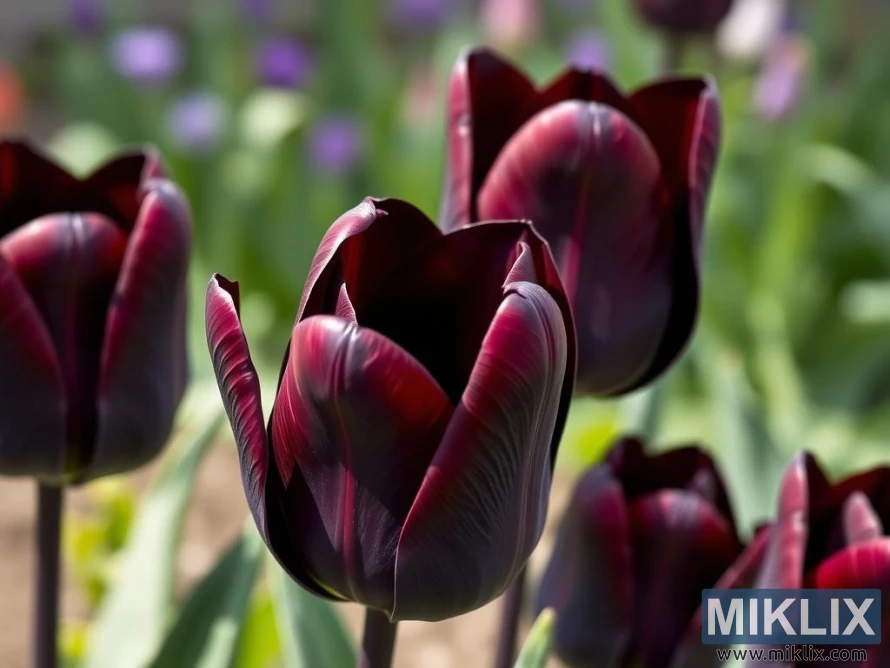Image: Black-Purple Tulips in Bloom
Published: August 22, 2025 at 9:00:28 AM UTC
Last updated: September 27, 2025 at 10:53:26 PM UTC
A cluster of luxurious black-purple tulips with velvety petals and maroon undertones, set against soft green stems and a blurred garden background.
The image captures the mesmerizing beauty of deep black-purple tulips, their velvety petals gleaming softly under the light, creating an aura of mystery and elegance. At first glance, the flowers seem almost black, but closer inspection reveals subtle maroon and burgundy undertones, giving them a richness that feels both luxurious and dramatic. The tulip in the foreground is partially open, its smooth petals arching outward in graceful curves that draw attention to the intricate textures and delicate striations along their surface. These fine lines catch the sunlight in faint glimmers, accentuating the contrast between shadow and sheen, and lending the bloom a sculptural quality. The velvety depth of color is captivating, as though each petal were brushed with a dark, silky finish that speaks of refinement and allure.
Surrounding this central bloom are several others of the same variety, slightly out of focus but still commanding with their striking form and color. Their blurred presence adds depth to the image, creating the impression of a thriving cluster rather than a solitary flower. The repetition of their dark tones in the background enhances the sense of abundance, while the softness of the focus conveys the delicacy of the garden environment. The upright stems, though only faintly visible, suggest strength and resilience, supporting these dramatic blossoms with quiet steadiness. Together, they form a scene that feels both intimate and expansive, allowing the viewer to focus on one bloom’s detail while also sensing the life and vitality of the garden as a whole.
The background further enriches the composition. Soft green hues of stems and foliage create a natural canvas against which the dark tulips stand out vividly, their richness intensified by the contrast. Here and there, hints of other purple blossoms emerge, adding a layer of harmony while also underscoring the unique depth of the tulips’ color. The play of light and shadow across the blurred backdrop provides subtle variation, suggesting a lively springtime garden without distracting from the central flowers. This layering of sharp focus and soft blur enhances the tulips’ presence, making them appear almost luminous in their dark elegance.
There is something profoundly evocative about these tulips. Their black-purple hue carries an air of sophistication and rarity, often associated with elegance, mystery, and depth of feeling. Unlike the bright exuberance of red or yellow tulips, these blooms seem to whisper rather than shout, drawing the observer in with quiet intensity. They embody contrast—dark yet luminous, refined yet natural, dramatic yet serene. Their beauty feels timeless, as if they belong both to the present springtime garden and to a more eternal realm of symbolism and emotion.
The image as a whole captures not just flowers but an atmosphere: a moment of stillness and contemplation amid the richness of nature’s palette. The dark tulips dominate the scene with their enigmatic charm, yet they are part of a greater whole, framed by light, color, and life in the garden around them. They speak to the complexity of beauty—sometimes bold and radiant, other times deep and shadowed, but always compelling. In their velvety petals, there is a story of elegance, rarity, and the artistry of nature at its most refined.
The image is related to: A Guide to the Most Beautiful Tulip Varieties for Your Garden

